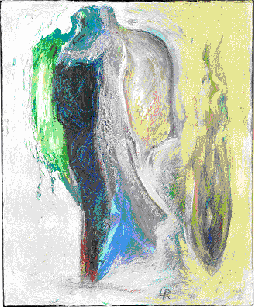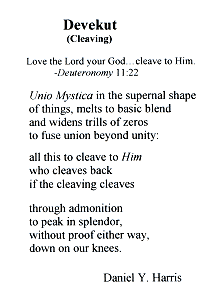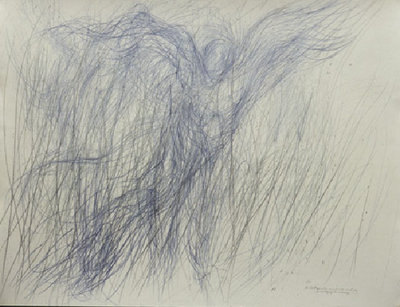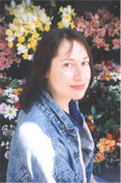Essays:The Art of Unio Mystica
From Content
| Revision as of 07:54, 10 April 2006 Andrey (Talk | contribs) ← Previous diff |
Current revision Andrey (Talk | contribs) |
||
| Line 9: | Line 9: | ||
| |} | |} | ||
| - | {| border=0 | + | ''Dedicated to Lisa Rose, Painter & Mystic'' |
| - | | valign=top | | + | |
| - | [[image:An Essay in the Art of Formation.1.1.jpg]] | + | His Higher soul longed to unite with her soul, which is the beginning without end, and the end without the beginning. |
| - | <font class=annotation>Detail #1 of ''Vessels, Pots & Jars''<br> | + | |
| - | Acrylic Painting by Carre Harris.</font> | + | :::<font class=annotation>''Abraham Abulafia, quoted from Studies in Ecstatic Kabbalah'' by Moshe Idel, Page 8, Note 41 from Biblioteque Nationale</font> |
| - | | | + | |
| - | [[image:An Essay in the Art of Formation.2.1.gif]] | + | Yahweh shaped an earthling from clay of this earth, blew into its nostrils the wind of life. |
| - | <font class=annotation>Detail #2 of ''Vessels, Pots & Jars''<br> | + | |
| - | Acrylic Painting by Carre Harris.</font> | + | :::<font class=annotation>''The Book of J, Section #1, Page 61'' Translated by David Rosenberg, Interpreted by Harold Bloom</font> |
| + | |||
| + | You shall not make for yourself a sculptured image, or any likeness of what is in the heavens above, or on the earth below, or in the waters under the earth. You shall not bow down to them or serve them. For I the Lord your God am an impassioned God, visiting the guilt of the parents upon the children, upon the third and upon the forth generations of those who reject Me, but showing kindness to the thousandth generation of those who love Me and keep My commandments. | ||
| + | |||
| + | :::<font class=annotation>Tanakh: The Holy Scripture, Exodus 20:4-6</font> | ||
| + | |||
| + | {| border=0 width=300 | ||
| + | | valign=top | [[image:The Art of Unio Mystica.1.jpg]] | ||
| + | | [[image:The Art of Unio Mystica.2.gif]] | ||
| + | | [[image:The Art of Unio Mystica.3.gif]] | ||
| + | |- | ||
| + | | colspan=3 | <font class=annotation>''Three paintings by Lisa Rose exemplifying the longing for'' ''the art of Unio Mystica and titled serially Spiritual Agency.''</font> | ||
| |} | |} | ||
| + | |||
| + | This essay speculates and, at times during its stint in the sanctum sanctorum, ruminates on the kabbalistic concept of '''''Unio Mystica''''' as an art to which the creation of art and by extension, the artist, is closely linked in an intimate bond. The author will limit his gaze to the medieval Spanish kabbalist Abraham Abulafia (1240-1292) as exemplar of '''''Unio Mystica''''', and the Oakland-based painter Lisa Rose whose paintings exemplify the agon at the center of '''''Unio Mystica''''' and/or its aspiration, creation and eventual surrender. | ||
| - | The painter Mark Rothko once declared to Seldom Rodman for his book, Conversations with Artists, (New York, 1957) that "the people who weep before my pictures are having the same religious experience I had when I painted them." By metaleptic reversal, the same can be said about the formational art of Carre Harris, whose painting ''Vessels, Pots & Jars'' (Acrylic and Graphite, 2002, 32 x 54) invokes the elegant and sublime movement of a primal scene of invention that is simultaneously cosmologic and quotidian. We gaze at the catastrophe of an imploding universe and the dark interior void of daily containers. Space is not an exegetical principal. It is an amalgam of reds, plums, turquoises, vivid blues and metallic coppers contained in and around six inexact circles, or spheres, roughing the periphery of the environment they are about to create. The formative is the essence: the resonant spaces and auric splendor of contour upon which we gaze and meditate and submit to an array of emotions for which tears are a pleasant release. | + | The '''''Unio Mystica''''' of Spanish kabbalist Abraham Abulafia (who was born in Spain, wrote prophetic books, tried to convert the Pope on the day the Pope died and for which he spent a month in prison rather than be executed, then wandered through Italy and Greece practicing and writing his concept of '''''Unio Mystica'''''), proposes to give unity meaning beyond the unified to blend the perfect amalgam of all potential disparity and return the seeker to the nondual from which all categories of humanity are spawned. Since disparity at its base occurs in oneself and extends outward to another, and then to the other ad infinitum, '''''Unio Mystica''''' is a trope of impossibility whose aim defies the common sense of human experience. '''''Unio Mystica''''' is indeed a mystical activity which seeks to restore the primordial bifurcation between humanity and divinity, and in so doing, merge disparity. In the history of Kabbalah (Jewish mysticism) Abraham Abulafia's kabbalah has been called "prophetic" and "ecstatic" by eminent scholars such as Gershom Scholem and Moshe Idel. The ecstatic kabbalist is different than the theological and literary kabbalist insofar as daily practice, invocation and attainment of the holy are concerned. In Abulafia's own words: "all the inner forces and the hidden souls in man are differentiated in the bodies. It is however in the nature of all of them that when their knots are untied, they return to their origin, which is one without any duality, and which comprises the multiplicity." (VeZot LiYihudah: Epistles of Abraham Abulafia) |
| - | Unlike one of Carre Harris's favorite painters Mark Rothko, doom doesn't dovetail ecstasy. The burden of an abandoned spatial loneliness doesn't invoke the dread of invention. We are neither ghostly nor abandoned within the confines of broken relations or flattered by the embellished void of a post-consumer society without meaning. This is neither apocalyptic nor nihilistic art informed by the ever-present trends of casual disinterest. The spiritual integrity of this painting is without question and as Carre Harris says with the confident humility of an artist at the height of her powers, "Things move in and out of space. They move apart. They influence one another. Chaos and the beautiful come together and split apart and come together again." We hear the voice of experience. It is neither self-deprecating nor damned with faint praise. Grand philosophical and artistic gestures are replaced with the calming norms of graceful colloquia. For it is the daily life that we see in these painterly spheres: daily life seen through an eye that sees into the heart of things and sees how we behave. Carre Harris sees as if she had spent several days of her life with other people's eyes, as if she had been able to remove her own eyes like contact lenses and then, when enough of an other's experience was seen, could put her own eyes back in. | + | '''''Unio Mystica''''' is the result of untying the knots, and as W.T. Stace says in Mysticism and Philosophy (quoted in Idel's Studies in Ecstatic Kabbalah: Notes to Chapter 1, Note #44) "The untying of the knots of the soul means the liberation from the fetters of finitude so that they return to their origin, which is the Infinite One." We can surmise from this metaphor that the act of untying knots is complicated, involves many steps, be they theurgic, calligraphic or contemplative. We can also surmise that the Infinite bares a multiplicity, yet, as Abulafia avers, a multiplicity without duality. The praxis which leads to '''''Unio Mystica''''' involves uniting two multiplicities or composites: one composite is human and bares an extended array of emotional, psychological and physical layers. The other composite is God which bares an infinite array of multiplicities, and/or, for the sake of relevance, names. The human composite merges with the God composite, and as Idel himself avers, "besides the formulae He is He, and I am He and He is I we get the formula I-I," which, Idel concludes, "is the meaning of the name Eheyeh asher Eheyeh." (Studies: Page. 11) Eheyeh asher Eheyeh popularly translated as "I am that I am", (the revelation on Mt. Sinai from God to Moses) could also mean "I am you, and you are Me." The trope is blasphemy and suggests that through a heightened act of untying knots and freeing the human composite, we, the humans become God, who is himself, a multiplicity. |
| - | {| border=0 | + | Abraham Abulafia spent his life untying the knots that kept his soul in fetters through the lexical and calligraphic artistry of the 22-letters of the Hebrew Alphabet. Though historiography presents Abulafia as a wandering mystic collecting a coterie of disciples for whom he enacted the role of the second Adam, the messiah returned, and for whom prophecy was a vocation, it is his poem on the nature of the 22-letters that informs this essay and will be the link to the art of Lisa Rose: |
| + | |||
| + | "When Yahweh spoke to me when I saw/His name spelled out in blood and/designated in my heart, separating/the blood from the ink and the ink from/the blood. And Yahweh said to me:/know that your soul's is blood/and ink is the name of your spirit." (The Battle of Blood and Ink: Abraham Abulafia, quoted from The Penguin Book of Hebrew Verse, T. Carmi, Page 417) The 22-letters are written or painted with the ink of the spirit, which is part of the aesthetic composite which links the human with God. God's beginning was to create the 22-letters of the Hebrew Alphabet, thus it is through the 22-letters that we return to God's multiplicity. The letters are at once philology and art. As philology a line can be designated from Sumerian and Akkadian Cuneiform to Egyptian Hieroglyphics, dividing again into Western Semitic Syllabic, Proto-Sinaitic, Proto-Canaanite, Proto-Hebraic, culminating in Aramaic and then Hebrew. As art, the 22-letters can be described as portraits of God that entail an act of artistry to manifest. Direct exemplifications of the art of 22-letters are calligraphy, such as in sections of the art of Marc Chagall, Wallace Berman and Abraham Pincas. Indirect exemplifications of the 22-letters are manifest in what Lisa Rose paints in her Spiritual Agency paintings, where symbolic and a-linguistic calligraphic shapes wrestle with color prior to the dark sublime of merging. | ||
| + | |||
| + | Lisa Rose's paintings are at once haunting and sublime. In ''''''Spiritual Agency'''''' (1.) ethereal figures have emerged from the recessed expanse of blue-gray to face each other moments before metamorphosis. The figure on the left (indirectly the Hebrew letter Lamed) is about to lift himself up from a brown thin chair. The figure on the right (indirectly the upside down Hebrew letter Shin), part animal, part angel/cherub, part human, is either what the figure on the left will become, or is separate and is thus part of the pre-merged form these two will become when they do in fact merge. Whichever interpretation is more apt, the core of this Spiritual Agency painting is the aesthetic pangs of the unitive experience seen during one of the many stages involved in the artistry of untying knots. In ''''''Spiritual Agency'''''' (2.) the space between the figures looks like a morphologic field curving toward itself to form two bonding Ayins, half an Alef, again, moments before melting to the perfect blend of nondual forms. Of crucial import to this painting is the proximity of the merging. One might surmise that this shape-shifted sequence of movement has nearly reached its unitive link. ''''''Spiritual Agency'''''' (3.) bares a close resemblance to (1.), if it is not one of the layered sequences of (1.) In this case, the figure on the left has risen red from a blue lift, to stand over the upside down Shin which has metamorphosed with a brilliant white silhouette of a head. This is clearly a composite, a multiplicity of form untying the knots to let the soul exit without fetters. | ||
| + | |||
| + | [[image:The Art of Unio Mystica.4.gif]] | ||
| + | 4) | ||
| + | |||
| + | [[image:The Art of Unio Mystica.5.gif]] | ||
| + | 5) | ||
| + | |||
| + | The unfettered soul cleaves (devekut) to the unitive through the 22-letters of the spirit and enacts, as mentioned, the rarity of joined mutual multiplicities (the lower soul with the higher soul.) Figure (4.) is a Lisa Rose ''''''Spiritual Agency'''''' painting entitled '''''Devekut''''' enacted to be in dialogue with the poem '''''Devekut''''', (5.) by this essay's author. The poem opens by invoking '''''Unio Mystica''''' and closes by invoking grace "down on our knees." The painting is a near combination of the Sufic Green Man of Light and the Hebrew letter Tsadi, and conveys a converging process. Two disparate forms, one pale-azure-green and the other amber-beige "melt to basic blend," and are about to metamorphose to become what the viewer would see an instant later were he existing as part of a fusion, the continuum as Abulafia envisioned. The terrible irony of this stipulation lies in the awareness that once merged, once returned to the nondual from which one began and through thousands of generations has repressed and fractured, the aesthetic is no longer necessary. That is that Art would no longer be necessary in a world where we were God. Were '''''Tikkun''''' (the restored world as developed by Safed kabbalist Isaac Luria 1534-1572) in place, this would be the case, but it is not. To appease the terror of this insight, we refer finally to Idel's view of Abulafia's role in the world, and thus, by our assertion, the role of the artist. Let us first quote the titular passage and then rewrite it. | ||
| + | |||
| + | "According to Abulafia, the mystic's duty is to remain in the spiritual state known as the unitive experience. The only reason to return from God or to escape this state, is when there is an urgent need to instruct the people, in order to bring them under the wing of the Divine Presence." (Studies in Ecstatic Kabbalah, Page 16.) | ||
| + | |||
| + | Revised version: According to '''''Daniel Y. Harris''''', Lisa Rose's duty is to remain in the spiritual state known as the unitive experience. The only reason to return from God or to escape this state, is when there is an urgent need to '''''create a work of art to bring people''''' under the wing of the Divine Presence. | ||
| + | |||
| + | This act of misprision is not facetious. It is rather an effort at sincerity so genuine and old that it frightens the author. Nonetheless and in conclusion, it is the Abulafian world that Lisa Rose conjures through her painting whether deliberately or by an undiluted longing for '''''Unio Mystica''''' which speaks through her. Her paintings are indeed '''''Spiritual Agencies''''' cleaving to what Moshe Idel says of Abulafia, "the primordial dynamic unity in the bosom of revealed divinity." ('''''Studies:''''' Page 18) The agon rests in the trials and labors of creation, that one interrupts eternity and takes a temporary hiatus from unity (which is in itself not duality, as we mentioned, but a dance of multiplicities) to do God's work. God's work is the archetype of creativity, since it is creativity that compelled the Infinite (which was not yet God) to make a space to create the perceptual field that is God in 22-letters, God in 22 multifaceted and extended paintings of himself in us to access. We celebrate the art of Lisa Rose and see that this is what she struggles with. For like the prophet Jeremiah, Lisa Rose struggles to hold in the pangs of divinity but cannot. What has manifested is a life's work of symphonic homunculus color forms merging in the primordial soup of divinity, a place our old friend Abraham Abulafia knew well. | ||
| + | |||
| + | [[image:The Art of Unio Mystica.6.jpg|400px]] | ||
| + | |||
| + | <font class=annotation>''From the '''Spiritual Agency''' Series by Lisa Rose''</font> | ||
| + | |||
| + | '''References''' | ||
| + | *Idel, Moshe. ''Studies in Ecstatic Kabbalah,'' State University of New York, 1988. | ||
| + | *Matt, Daniel. ''The Zohar: The Book of Enlightenment.'' Paulist Press, 1983. | ||
| + | *Rosenberg, David & Bloom, Harold. ''The Book of J,'' Grove Weidenfeld, 1990. | ||
| + | *''Tanakh, The Holy Scriptures.'' The Jewish Publication Society, 1985. | ||
| + | *Carmi, ''T. The Penguin Book of Hebrew Verse,'' New York, 1981 | ||
| + | *Meltzer, David. ''The Secret Garden.'' Seabury Press, 1976. | ||
| + | *Rose, Lisa. ''www.realhuman.org.'' | ||
| + | |||
| + | |||
| + | {| border=0 | ||
| | valign=top | | | valign=top | | ||
| - | [[image:An Essay in the Art of Formation.1.1.jpg]] | + | {| align=left border=0 style="margin-top: .9em; margin-right: 1em" |
| - | <font class=annotation>Detail #3 of ''Vessels, Pots & Jars''<br> | + | | [[image:The Art of Unio Mystica.Lisa Rose.jpg]] |
| - | Acrylic Painting by Carre Harris.</font> | + | |} |
| - | | | + | <font class=annotation> |
| - | [[image:An Essay in the Art of Formation.2.1.gif]] | + | '''Lisa Rose'''<br> |
| - | <font class=annotation>Detail #3 of ''Vessels, Pots & Jars''<br> | + | ''artist's statement'' |
| - | Acrylic Painting by Carre Harris.</font> | + | |
| - | |} | + | |
| - | What do these evocative spheres contain? In the artists own words, "These six spheres are aligned by color. The orange one is a water-jug. The spilled water forms rings. The red one has an object in the middle that could either be a feather, a hand, a heart, a lady's pin, or all these things... a suggestion of these things. Another one is both organic and synthetic: a stem, a bulb, a giant flower and also electrical lines or fiber optic lines. One is a veiled woman. One is coiling like a snake. They are worlds forming." Which ever of these visual correlatives the viewer chooses to take, if any, suggestiveness is replete and the potential is nothing less than life giving. | + | The visual and performing arts provide a way for me to explore spiritual agency as a catalyst for change. In most of my current work there are agents exchanging and/or exhibiting a force or power. I suggest spiritual agency through a change in color or texture as well as through anthropomorphic forms. In this series, I tend to conceive ideas out of the physical process itself of painting or drawing (not unlike the surrealists' automatism) asking constantly what the work wants to reveal rather than what I want the work to reveal. I use an "improvisational" approach similar to that which I learned as a composer and musician studying and working with wonderful artists including the Art Ensemble of Chicago, Leo Smith, Jim Pepper, and Sonny King. |
| - | As with any procreative act, Carre Harris had widely photographed ''Vessels, Pots & Jugs'' and produced an arsenal of photographs which she is arranging as collage and photomontage like a choreographer. One may even suggest that ''Vessels, Pots & Jugs'' is the mothership, the great primeval Gaia, the archetypal womb from which Carre Harris will people a new imaginative world with her new/old creatures. One is also tempted to attribute to this painting Kabbalistic and Gnostic qualities, and one would not be incorrect but rather a bit too mimetic. This painting is more about the future than it is about the apt mysterious scenarios of the past. Carre Harris is rather more a happy futurist endowed with a classical sensibility than a re-inventor of suggestive prior scenarios. | + | I work in the "gestural" tradition of Nathan Oliveira and others. I like to work in oil because of its great plasticity and texture. As a trained dancer, I have always been compelled to use my entire body in the process of painting and drawing - an approach influenced by training in dance under Bella Lewitzky and others. Working in such viscose media as oil, chalk, and graphite enables me to feel the image taking shape in much the same way a dancer creates shape using gravity in 3 dimensional space. In this way, I may hopefully serve as an agent exchanging the power of movement and spirit with a viewer who might experience something similar. |
| + | |||
| + | I am influenced by all the creative arts as well as literature and theatre. I am particularly influenced by science and theology finding inspiration especially in physics (the "quantum" stuff) and the life of the soul as perceived by the Jewish mystics in the Kabbalah. Yes, I am Jewish however, I did not learn about Jewish mysticism, per se, until after I began my spiritual agency series. When a theology student at one of my showings drew such startling associations between these ideas and my artwork, I became compelled to explore this area of my own heritage further. | ||
| + | |||
| + | Born and raised in California where I received my BFA from the California Institute of the Arts, I grew up in a family of talented and accomplished (though nobody has become famous yet) artists and have lived and worked on the west coast all my life. | ||
| + | </font> | ||
| + | |} | ||
Current revision
by Daniel Y. Harris
| Daniel Y. Harris is a poet, visual artist and essayist who lives in Oakland California and teaches courses in Jewish mysticism and kabbalah through Lehrhaus Judaica. He is Director of Communications for MesArt, and has been Board Secretary and Co-Curator of Art for Artship Foundation. He was born in Paris, France, and came to the United States with his family at the age of ten. Daniel holds a Master of Arts in Divinity from the University of Chicago, and wrote his dissertation in the studies of medieval and contemporary Kabbalistic thought. Daniel has exhibited his sculptural work in galleries and museums in Chicago, Minneapolis, San Francisco and Oakland, and more recently at The Euphrat Museum in Cupertino CA. He is currently working on a manuscript for a first book of poetry entitled The Arrival, and a book on the life of Medieval Kabbalist Moses de Leon, includes The Denver Quarterly, Panoply & PoetryMagazine.Com among his publication credits. He is also assisting in Coordinating reading events for Poets for Peace and is judge for its Peace Sculpture Competition 2002. |
Dedicated to Lisa Rose, Painter & Mystic
His Higher soul longed to unite with her soul, which is the beginning without end, and the end without the beginning.
- Abraham Abulafia, quoted from Studies in Ecstatic Kabbalah by Moshe Idel, Page 8, Note 41 from Biblioteque Nationale
Yahweh shaped an earthling from clay of this earth, blew into its nostrils the wind of life.
- The Book of J, Section #1, Page 61 Translated by David Rosenberg, Interpreted by Harold Bloom
You shall not make for yourself a sculptured image, or any likeness of what is in the heavens above, or on the earth below, or in the waters under the earth. You shall not bow down to them or serve them. For I the Lord your God am an impassioned God, visiting the guilt of the parents upon the children, upon the third and upon the forth generations of those who reject Me, but showing kindness to the thousandth generation of those who love Me and keep My commandments.
- Tanakh: The Holy Scripture, Exodus 20:4-6
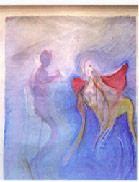
| 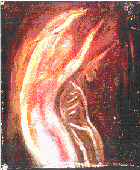
| 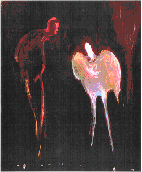
|
| Three paintings by Lisa Rose exemplifying the longing for the art of Unio Mystica and titled serially Spiritual Agency. | ||
This essay speculates and, at times during its stint in the sanctum sanctorum, ruminates on the kabbalistic concept of Unio Mystica as an art to which the creation of art and by extension, the artist, is closely linked in an intimate bond. The author will limit his gaze to the medieval Spanish kabbalist Abraham Abulafia (1240-1292) as exemplar of Unio Mystica, and the Oakland-based painter Lisa Rose whose paintings exemplify the agon at the center of Unio Mystica and/or its aspiration, creation and eventual surrender.
The Unio Mystica of Spanish kabbalist Abraham Abulafia (who was born in Spain, wrote prophetic books, tried to convert the Pope on the day the Pope died and for which he spent a month in prison rather than be executed, then wandered through Italy and Greece practicing and writing his concept of Unio Mystica), proposes to give unity meaning beyond the unified to blend the perfect amalgam of all potential disparity and return the seeker to the nondual from which all categories of humanity are spawned. Since disparity at its base occurs in oneself and extends outward to another, and then to the other ad infinitum, Unio Mystica is a trope of impossibility whose aim defies the common sense of human experience. Unio Mystica is indeed a mystical activity which seeks to restore the primordial bifurcation between humanity and divinity, and in so doing, merge disparity. In the history of Kabbalah (Jewish mysticism) Abraham Abulafia's kabbalah has been called "prophetic" and "ecstatic" by eminent scholars such as Gershom Scholem and Moshe Idel. The ecstatic kabbalist is different than the theological and literary kabbalist insofar as daily practice, invocation and attainment of the holy are concerned. In Abulafia's own words: "all the inner forces and the hidden souls in man are differentiated in the bodies. It is however in the nature of all of them that when their knots are untied, they return to their origin, which is one without any duality, and which comprises the multiplicity." (VeZot LiYihudah: Epistles of Abraham Abulafia)
Unio Mystica is the result of untying the knots, and as W.T. Stace says in Mysticism and Philosophy (quoted in Idel's Studies in Ecstatic Kabbalah: Notes to Chapter 1, Note #44) "The untying of the knots of the soul means the liberation from the fetters of finitude so that they return to their origin, which is the Infinite One." We can surmise from this metaphor that the act of untying knots is complicated, involves many steps, be they theurgic, calligraphic or contemplative. We can also surmise that the Infinite bares a multiplicity, yet, as Abulafia avers, a multiplicity without duality. The praxis which leads to Unio Mystica involves uniting two multiplicities or composites: one composite is human and bares an extended array of emotional, psychological and physical layers. The other composite is God which bares an infinite array of multiplicities, and/or, for the sake of relevance, names. The human composite merges with the God composite, and as Idel himself avers, "besides the formulae He is He, and I am He and He is I we get the formula I-I," which, Idel concludes, "is the meaning of the name Eheyeh asher Eheyeh." (Studies: Page. 11) Eheyeh asher Eheyeh popularly translated as "I am that I am", (the revelation on Mt. Sinai from God to Moses) could also mean "I am you, and you are Me." The trope is blasphemy and suggests that through a heightened act of untying knots and freeing the human composite, we, the humans become God, who is himself, a multiplicity.
Abraham Abulafia spent his life untying the knots that kept his soul in fetters through the lexical and calligraphic artistry of the 22-letters of the Hebrew Alphabet. Though historiography presents Abulafia as a wandering mystic collecting a coterie of disciples for whom he enacted the role of the second Adam, the messiah returned, and for whom prophecy was a vocation, it is his poem on the nature of the 22-letters that informs this essay and will be the link to the art of Lisa Rose:
"When Yahweh spoke to me when I saw/His name spelled out in blood and/designated in my heart, separating/the blood from the ink and the ink from/the blood. And Yahweh said to me:/know that your soul's is blood/and ink is the name of your spirit." (The Battle of Blood and Ink: Abraham Abulafia, quoted from The Penguin Book of Hebrew Verse, T. Carmi, Page 417) The 22-letters are written or painted with the ink of the spirit, which is part of the aesthetic composite which links the human with God. God's beginning was to create the 22-letters of the Hebrew Alphabet, thus it is through the 22-letters that we return to God's multiplicity. The letters are at once philology and art. As philology a line can be designated from Sumerian and Akkadian Cuneiform to Egyptian Hieroglyphics, dividing again into Western Semitic Syllabic, Proto-Sinaitic, Proto-Canaanite, Proto-Hebraic, culminating in Aramaic and then Hebrew. As art, the 22-letters can be described as portraits of God that entail an act of artistry to manifest. Direct exemplifications of the art of 22-letters are calligraphy, such as in sections of the art of Marc Chagall, Wallace Berman and Abraham Pincas. Indirect exemplifications of the 22-letters are manifest in what Lisa Rose paints in her Spiritual Agency paintings, where symbolic and a-linguistic calligraphic shapes wrestle with color prior to the dark sublime of merging.
Lisa Rose's paintings are at once haunting and sublime. In 'Spiritual Agency' (1.) ethereal figures have emerged from the recessed expanse of blue-gray to face each other moments before metamorphosis. The figure on the left (indirectly the Hebrew letter Lamed) is about to lift himself up from a brown thin chair. The figure on the right (indirectly the upside down Hebrew letter Shin), part animal, part angel/cherub, part human, is either what the figure on the left will become, or is separate and is thus part of the pre-merged form these two will become when they do in fact merge. Whichever interpretation is more apt, the core of this Spiritual Agency painting is the aesthetic pangs of the unitive experience seen during one of the many stages involved in the artistry of untying knots. In 'Spiritual Agency' (2.) the space between the figures looks like a morphologic field curving toward itself to form two bonding Ayins, half an Alef, again, moments before melting to the perfect blend of nondual forms. Of crucial import to this painting is the proximity of the merging. One might surmise that this shape-shifted sequence of movement has nearly reached its unitive link. 'Spiritual Agency' (3.) bares a close resemblance to (1.), if it is not one of the layered sequences of (1.) In this case, the figure on the left has risen red from a blue lift, to stand over the upside down Shin which has metamorphosed with a brilliant white silhouette of a head. This is clearly a composite, a multiplicity of form untying the knots to let the soul exit without fetters.
The unfettered soul cleaves (devekut) to the unitive through the 22-letters of the spirit and enacts, as mentioned, the rarity of joined mutual multiplicities (the lower soul with the higher soul.) Figure (4.) is a Lisa Rose 'Spiritual Agency' painting entitled Devekut enacted to be in dialogue with the poem Devekut, (5.) by this essay's author. The poem opens by invoking Unio Mystica and closes by invoking grace "down on our knees." The painting is a near combination of the Sufic Green Man of Light and the Hebrew letter Tsadi, and conveys a converging process. Two disparate forms, one pale-azure-green and the other amber-beige "melt to basic blend," and are about to metamorphose to become what the viewer would see an instant later were he existing as part of a fusion, the continuum as Abulafia envisioned. The terrible irony of this stipulation lies in the awareness that once merged, once returned to the nondual from which one began and through thousands of generations has repressed and fractured, the aesthetic is no longer necessary. That is that Art would no longer be necessary in a world where we were God. Were Tikkun (the restored world as developed by Safed kabbalist Isaac Luria 1534-1572) in place, this would be the case, but it is not. To appease the terror of this insight, we refer finally to Idel's view of Abulafia's role in the world, and thus, by our assertion, the role of the artist. Let us first quote the titular passage and then rewrite it.
"According to Abulafia, the mystic's duty is to remain in the spiritual state known as the unitive experience. The only reason to return from God or to escape this state, is when there is an urgent need to instruct the people, in order to bring them under the wing of the Divine Presence." (Studies in Ecstatic Kabbalah, Page 16.)
Revised version: According to Daniel Y. Harris, Lisa Rose's duty is to remain in the spiritual state known as the unitive experience. The only reason to return from God or to escape this state, is when there is an urgent need to create a work of art to bring people under the wing of the Divine Presence.
This act of misprision is not facetious. It is rather an effort at sincerity so genuine and old that it frightens the author. Nonetheless and in conclusion, it is the Abulafian world that Lisa Rose conjures through her painting whether deliberately or by an undiluted longing for Unio Mystica which speaks through her. Her paintings are indeed Spiritual Agencies cleaving to what Moshe Idel says of Abulafia, "the primordial dynamic unity in the bosom of revealed divinity." (Studies: Page 18) The agon rests in the trials and labors of creation, that one interrupts eternity and takes a temporary hiatus from unity (which is in itself not duality, as we mentioned, but a dance of multiplicities) to do God's work. God's work is the archetype of creativity, since it is creativity that compelled the Infinite (which was not yet God) to make a space to create the perceptual field that is God in 22-letters, God in 22 multifaceted and extended paintings of himself in us to access. We celebrate the art of Lisa Rose and see that this is what she struggles with. For like the prophet Jeremiah, Lisa Rose struggles to hold in the pangs of divinity but cannot. What has manifested is a life's work of symphonic homunculus color forms merging in the primordial soup of divinity, a place our old friend Abraham Abulafia knew well.
From the Spiritual Agency Series by Lisa Rose
References
- Idel, Moshe. Studies in Ecstatic Kabbalah, State University of New York, 1988.
- Matt, Daniel. The Zohar: The Book of Enlightenment. Paulist Press, 1983.
- Rosenberg, David & Bloom, Harold. The Book of J, Grove Weidenfeld, 1990.
- Tanakh, The Holy Scriptures. The Jewish Publication Society, 1985.
- Carmi, T. The Penguin Book of Hebrew Verse, New York, 1981
- Meltzer, David. The Secret Garden. Seabury Press, 1976.
- Rose, Lisa. www.realhuman.org.

